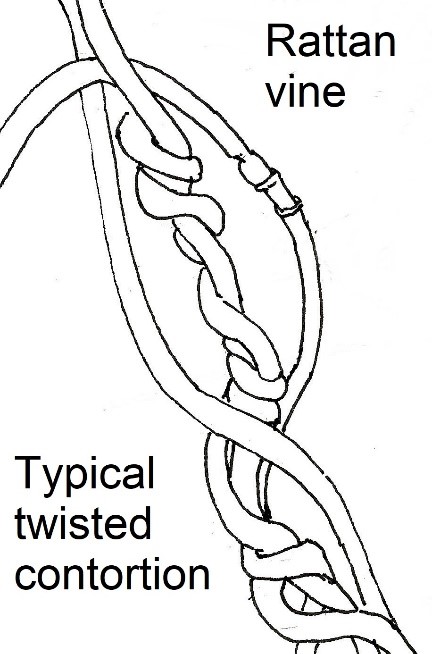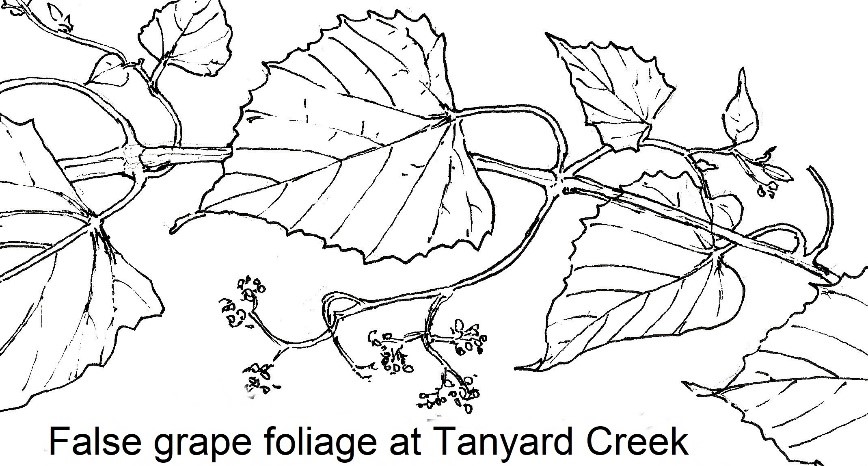Some vines are a familiar part of the Ozark outdoors. We easily recognize grape vines and constantly worry about poison ivy. The latter makes us aware that Virginia creeper vines grow in the same environment as poison ivy and we know that three leaflets are bad while five are good (or at least harmless). The other vine we all know and often curse is the family of species known collectively as greenbrier. Greenbrier is common almost everywhere, entwining shrubs and encroaching on trails. The stems are thin but tough enough to trip a horse and are studded with spines that tear both flesh and clothing. Greenbrier is even a concern for gardeners, because birds spread the little blue-black berries far and wide, and once greenbrier seedlings are established in your flower beds, they are nearly impossible to extinguish. So, grapes are at least innocuous even if their fruit is either too sour or too seedy to bother with. Their vines keep mostly above our heads and their stems never carry any vicious spines.
Two other common vines often escape notice because they look so much like the others we find so familiar. One of these is the rattan vine aka supple jack (Berchemia scandans). When I first met this vine on my earliest hikes in the Ozarks, I described it in my notes as a peculiar over-achieving form of greenbrier. The vine has entwining greenish brown stems like greenbrier, but they can be more than an inch thick and can be part of a swarm of a dozen or more such vines entangled in a complicated embrace and suspended from a good-sized tree.
Unless the unusual thickness or corkscrew tangles of these vines catch your attention, they look so much like greenbrier in growth form that you don’t notice the lack of nasty spines or that they rarely form ground-trailing tripwires. Yet every now and then rattan vine attracts your attention when it forms a mass of impossibly entwined stems, many with a fantastic corkscrew shape.

The corkscrews arise when vines wrap themselves around a small branch and then that branch dies. The dead wood soon decays and the corkscrew is left behind. There are also lengths of vine that have spirals embedded in their surface where other vine tendrils were once wrapped around and have since fallen away. So, you occasionally see corkscrews within corkscrews!

Another common vine (false or raccoon grape, Ampelopsis arborea) is regularly taken as a variety of grape to which it is only distantly related. Heavy false grape cables are seen looping down from high up in the canopies of streamside giants such as sycamore, hackberry and elm. In fact, the flood-ravaged banks of Ozark streams seem to be the preferred habitat of this species. The sign that these are not grapevines is the distinctive deeply ridged bark of these suspended cables. Grapes have fibrous, dark brown bark peeling off in thin shreds. False grape vines have lighter brown color and very prominent corky ridges.
There are several varieties of grapes in our area and they are distributed throughout our forest, while false grape vines are mostly associated with streambanks where they remind one of the thick mooring cables from a dockside ocean liner.
Both rattan and false grape vines are hard to identify by hikers using available references such as Carl Hunter’s book, Trees, Shrubs and Vines of Arkansas (out-of-print but a new field guide is being produced by the Ozark Society Foundation to be released soon). Proper identification took me some time after I first encountered them. Rattan vine is listed with other buckthorn relatives which are shrubs. Photos or drawings do not emphasize that it grows as an arboreal vine while you can hardly see the leaves and berries hidden aloft for comparison with illustrations. The false grape vine is shown as a trailing vine, but with thin stems and tendrils. The confusion is compounded by the description of the vine’s bark as light brown and smooth – not just by Hunter, but by all the references I can find online.

We see the leaves high up in the treetops where they are hard to distinguish from grape leaves, while the thick vine cables we see hanging down have that distinctively ridged bark that is ignored in most references. Where can you go to see these unusual vines? Two interesting displays of rattan vine are found along the upper half of the Shepard’s Spring trail loop (my illustration here) at Lake Fort Smith, and on the Ozark Highlands Trail nearby along Jacks Fork a mile or so beyond where the trail crosses Frog Bayou.
Some dramatic displays of false grape can be seen where vine cables as much as four inches thick are draped from the tallest trees along Avalon Creek on the nature trail in Tanyard Creek Park in Bella Vista. I won’t mention the fact that some of the tree and shrub labels you see there may be somewhat in error. There are enough of those sturdy false grape cables strung around to make even Tarzan himself happy to visit Tanyard Creek Park.
